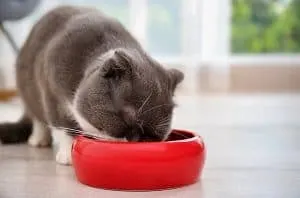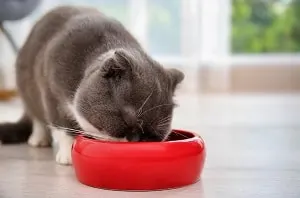 We often see our cats as independent creatures who can be hearty and built to survive. While cats are incredible animals, the fact is that cats can’t live long without food. So, how long can a cat live without food?
We often see our cats as independent creatures who can be hearty and built to survive. While cats are incredible animals, the fact is that cats can’t live long without food. So, how long can a cat live without food?
Cats can only live 3 or 4 days without food. Cats can live a week, at most, without eating, even if they are continuing to hydrate and drink water. Going long periods without protein can cause cats to suffer from liver and kidney failure.
A cat’s body is not built to go long periods without eating. Cats are “obligate carnivores,” meaning that they are missing an enzyme that converts beta-carotene (from plants) into Vitamin A. This means a cat must get its Vitamin A from an animal-based protein source; in essence, the liver of a fleshy prey.
It doesn’t take long for a cat to burn through protein; it’s main fuel source. Once a cat has used up protein, it begins to use up fatty stores. A cat’s liver is not built to process a large quantity of fat, since as we said, a cat is built to use protein as it’s fuel source.
Once a cat switches to processing fatty storages, we start to see issues due to not eating for a couple of days.
What Happens If A Cat Doesn’t Eat For 3 Days
It doesn’t take long for a cat to feel the effects of starvation. After three days of not eating, the body begins to bombard the liver with fat, as the protein stores are depleted. This leads to a condition known as hepatic lipidosis. This is a hazardous condition that inevitably leads to liver failure.
Once liver failure sets in, the rest of the organs soon follow. The kidneys start to shut down as the cat becomes dehydrated. The digestive system begins to give out, followed by the brain, and, finally, the heart.
How To Keep Your Cat Eating While You Are Away
The best-case scenario is to have someone check in on your cats and feed them for you while you are away or to check them into a kennel.
However, if this isn’t an option, it is possible to make sure your cats receive adequate food while you are gone. Assuming your cat doesn’t have hyperthyroidism or another disorder that causes your cat to overeat, they will usually regulate their food intake on their own. You can fill a large bowl or pan with the number of meals they would eat, plus a little extra. You may find upon your return that they have consumed much of it but not finished it.
You can also try an automatic cat feeder to portion out your cat’s meals while you are gone, but be sure to introduce them to this long before you leave, so that they can get used to it and are not afraid of it.
Why Would A Cat Not Eat
There are a vast number of reasons a cat would refuse to eat. These reasons mainly fall under the categories of a disease/physical illness, issues with the food itself, or psychological reasons.
Disease/Physical Illness
Just like humans, cats may experience a loss of appetite when they are ill. They may also be experiencing a serious issue such as a digestive blockage that may be causing physical pain when eating. Diseases or illnesses that may be causing your cat not to eat include:
- Dental Problems
- A Foreign Object Obstructing the Digestive System
- Respiratory Issues
- Arthritis
- Digestive Illnesses
- Pancreatitis
Issues with Food
There are several possible issues your cat may have with the food itself. Your cat may be picky with food like a toddler might be, or there may be a severe issue with the food itself. Your cat may refuse food for some of the following reasons:
- Shape
- Size
- Texture
- Flavor
- Spoilage
- Food Recall (For instance, perhaps there are metal shavings in the food or another foreign object that the cat senses).
Psychological Issues
Also, like humans, cats may have a poor appetite for psychological reasons. Psychological causes might include:
- Stress
- Depression
- Change in Environment or Travel
- Pickiness
- Trauma
Other causes could include environmental disruptions such as loud noises, high traffic, and food placement, among others. On that note, it is essential to keep food out of the vicinity of the litter box. Cats, unsurprisingly, will not eat food that is too close to the place in which they eliminate waste.
Another thing to keep in mind is whether or not your cat is on medications or has recently been vaccinated.
These may have side effects, which may cause your cat to be disinterested in food.
How Long Can A Sick Cat Go Without Eating
A sick cat can not go long without eating.
Their organs begin to shut down very quickly. A cat can go 3-4 days without eating, but a sick cat may have even less time. It is essential to look for signs that your cat may be sick, including extreme fatigue, fever, non-responsiveness, vomiting, or diarrhea. If you notice these things in connection with your cat not eating for 24 hours, it is advisable to seek medical attention for your feline.
If your cat is sick, it is important to try to gently coax it to eat. If it will not do so, even after gentle coaxing, a veterinarian may need to intervene with an alternative form of nourishment.
Can You Force Feed A Cat
Yes, although this is best done by a veterinarian, or, at least, under their careful guidance and instruction. However, there are plenty of tips and tricks to help you, as the owner, attempt to gently coax your cat into eating before making that trip to the vet’s office.
First things first, its best to start by gradually reintroducing food, especially if your cat has been sick. Doing this slowly helps your cat’s gut from being overwhelmed, causing it to regurgitate the food. Do this by offering small amounts of food by hand or a liquid alternative approved by your vet through a dropper. Reinforce positive results with praise.
Secondly, try offering a different option for food.
If your cat regularly eats dry food, try offering wet canned food, or adding a gravy flavoring to the dry food.
Switch up the flavor or brand of dry food. You can also incorporate special treats throughout dry food to entice your cat to eat dry food. If you bury some of the treats under the food, you may get lucky and find your cat eating bits of food to get to the special treats.
Another trick is to add small amounts of canned tuna in water, or canned chicken to food or even pour a small amount of tuna water from the can onto dry food. Be sure not to feed too much tuna to your cat, however, as it can cause other issues.
So, use this trick in moderation.
Adding small amounts of liver is another possible solution. As we mentioned before, liver provides cats with a direct source of Vitamin A.
Again, only provide this in small amounts because it is possible to cause a vitamin overdose.
Other things you can try at home are adding cooked eggs or broth. Also, try warming wet food a little. Likewise, you can simply change the texture of the food from plate to minced, or the other way around. Whichever of these tricks you decide to use, the biggest thing to remember is always to provide fresh food for your cat. If the food is wet and sits out for too long, it will harden and become undesirable, which may even do more damage in your mission of trying to get your cat to eat, as it may deter your cat from wanting to eat that type of food in the future.
If your cat refuses to eat, other things can be done.
What Do You Feed A Cat That Refuses To Eat
If your cat refuses to eat, extreme measures may need to be taken. If you have tried the tips and tricks noted above, and they don’t seem to be helping, it is time to take your cat to the vet. Your feline may have some illness or physical complications that are preventing it from eating. Your vet can then help you with a special diet or provide additional solutions.
It will be important to inform your veterinarian of any additional symptoms and exactly how long it has been since the last time your cat ate. It is an excellent idea to let them know how much your cat ate at its last meal.
Your veterinarian may prescribe special food for your cat or perhaps an appetite stimulant such as mirtazapine or cyproheptadine. Your vet will likely recommend a liquid diet through a syringe.
Other solutions your vet may opt for as a last resort are a nasogastric tube through the nose, an esophagostomy tube which is sewn into the side of the neck, or a PEG tube (Percutaneous Endoscopic Gastronomy) which can be placed in the cat’s side and then directly into the stomach.
Tube feeding will consist of pushing a slurry of food from a syringe, slowly through the tube. You can also use this to provide hydration and additional vitamins and medications. If your vet determines tube feeding is the best option for your cat, they will teach you how to tube feed your cat and keep the tube and incision site clean and well cared for.
Can A Cat Starve Itself To Death
Yes. A cat can starve itself to death. Your veterinarian can tell you what amount of food is right for your cat to consume, as different cats’ needs can vary.
Typically, cats need between 25 and 35 calories a day. If your cat is sick and has no appetite, you need to be your cat’s advocate. Keep an eye out for odd behavior and other symptoms.
Log your cat’s meal portions and meal times.
Intervene if your cat is not eating on its own and get your cat to the vet if your cat doesn’t eat anything for a couple of days. This could be the difference between life and death for your cat.

My name is James, and welcome to FAQCats!
Along with our team of cat owners, expert pet enthusiasts, and pet professionals, we aim to write engaging helpful, engaging content about cats. At FAQCats we strive to provide content that’s accurate and fun to read. Our team writes about everything related to cats; even the most complex of topics. Through extensive research and caring for our own fur-pals, we’re able to provide something cat owners worldwide will love. Have a look around, and leave us feedback anytime!

